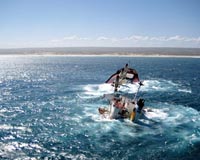| . |  |
. |
Leipzig, Germany (SPX) Sep 10, 2009 Contaminants from natural coal deposits in the Gulf of Alaska are not easily bioavailable, unlike the crude oil from the Exxon Valdez tanker catastrophe. This clearly disproves the theory that natural coal deposits were the cause of observed environmental damage. PAH pollutants were blamed for the continuing degradation of the ecosystem off the coast of Alaska. Then a dispute erupted over the origins of these pollutants in science. According to an international team of researchers writing in specialist journal "Environmental Science and Technology", the crude oil from the Exxon Valdez was the main source of the bioavailable PAH contaminants. The scientists from Tennessee Technological University, the University of Lausanne, Calvin College and the Helmholtz Centre for Environmental Research (UFZ) compared polycyclic aromatic hydrocarbons (PAHs) in samples of tanker oil and from coal deposits. Their investigation with bacterial biosensors has now shown that only the PAHs from the tanker oil had any effect on organisms. The scientists were able to prove this in the lab with the help of genetically engineered bacteria which react with the contaminants. "These biosensors are based on bacteria which feed on polycyclic aromatic hydrocarbons. If these bacteria come into contact with these substances, it flips a biological switch and the bacteria start to glow", explains Prof. Hauke Harms from the UFZ. "There are clear advantages to this new forensic application: there is no need to take the indirect route of costly chemical analysis to prove results." As the bacteria used give off a great deal of light, the scientists are able to study the processes at a high resolution - down to a microscopic level in individual organisms Polycyclic aromatic hydrocarbons are a natural component of coal and petroleum. Because of their longevity and toxicity, sixteen of these substances were classed as particularly hazardous environmental pollutants as far back as the 1980s by the American environmental agency EPA. Adhesives containing coal tar were thus prohibited, as a health hazard. Some PAHs are unambiguously carcinogenic - as long as they are metabolised by the organism. Their bioavailability thus determines their toxicity. They are generally only bioavailable if the substances are water-soluble. When the Exxon Valdez spilled its load on a reef in March 1989, about 40,000 tonnes of crude oil escaped and polluted the Prince William Sound. It is estimated that of seabirds alone, more than a quarter of a million were killed in the spill. Two thousand kilometres of coast were polluted with oil, bringing an end to fishing, and thus the livelihoods of many people living on the coast. According to ExxonMobil, the owner of the tanker, in a statement on the 20th anniversary of the spill, the company has paid out more than 3.8 billion dollars in compensation, clearance work, out-of-court agreements and fines. Despite a large-scale clean-up, there are still lingering effects on the environment. An estimated 80,000 litres of oil in the form of lumps of oil and tar are still said to pollute the coast of Alaska. The consequences are now no longer evident. But they cause, however, that marine organisms are damaged and the food chain no longer work as before. The main problem is that the polycyclic aromatic hydrocarbons in the oil only decompose slowly due to the low Arctic temperatures. Share This Article With Planet Earth
Related Links Helmholtz Association of German Research Centres Our Polluted World and Cleaning It Up
 Madagascar slick clean-up under way
Madagascar slick clean-up under wayNairobi (AFP) Sept 5, 2009 Clean-up operations following the grounding of a Turkish-flagged vessel off the coast of Madagascar have started and damage to the environment should be limited, the ship's operator said in a statement received by AFP Saturday. The MV Gulser Ana grounded off Faux Cap, on the southernmost tip of the Indian Ocean island, on August 26, damaging its bunker tanks and releasing fuel oil in the ... read more |
|
| The content herein, unless otherwise known to be public domain, are Copyright 1995-2009 - SpaceDaily. AFP and UPI Wire Stories are copyright Agence France-Presse and United Press International. ESA Portal Reports are copyright European Space Agency. All NASA sourced material is public domain. Additional copyrights may apply in whole or part to other bona fide parties. Advertising does not imply endorsement,agreement or approval of any opinions, statements or information provided by SpaceDaily on any Web page published or hosted by SpaceDaily. Privacy Statement |